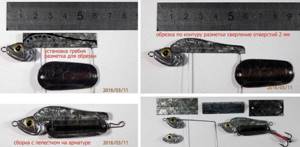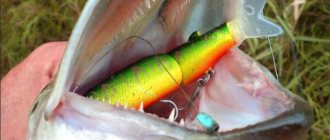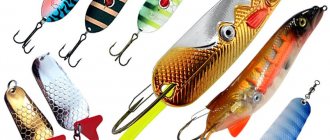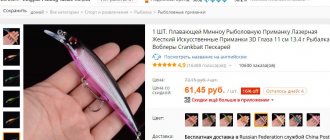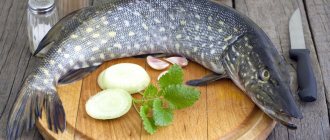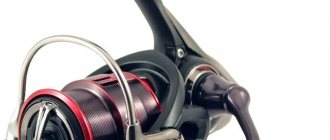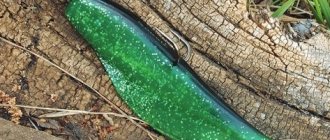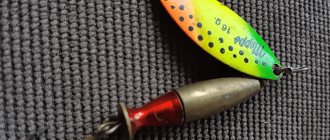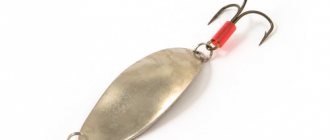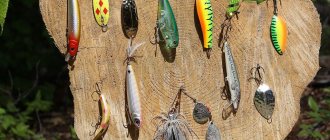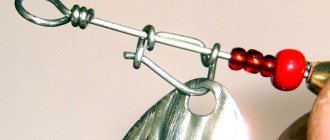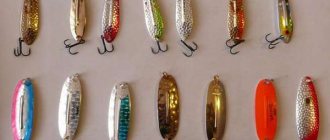Why have many fishermen lost interest in them? Are they really that bad? Should we forget about them?
I have been collecting Soviet-made spinner spoons for a long time, and I test each one using a specially developed system, calculating the actual catchability. Why do this when my boxes are full of excellent wobblers and full of working rubber? Yes, because the Soviet spinner is a resurgent brand, implying very catchy and expensive baits.
However, the price does not matter much for connoisseurs of the classics. Auctions are held on the Internet, where original Soviet spoons sell like hot cakes at a price comparable to an excellent modern wobbler. And these baits are bought in the desire to pay tribute to the masters of the past, who proved that the price of a bait is not an indicator of its catchability.
Decreased interest in vibrations
After the collapse of the USSR, interest in oscillators began to decline. With the advent of rubber, many spinning anglers switched to it, considering it more catchy and better adapted to a wide variety of lake and river fishing conditions. And with the advent of fashion for wobblers, modern spinning rods turned away from spinners altogether. This was largely due to the dominance of low-quality spinners that appeared on sale. For many, the spinner has become some kind of crappy bait, which is more or less suitable only for catching autumn pike. The situation was slightly improved by the appearance of modern Scandinavian, American, Canadian, and Japanese spinners, raising the prestige of the spinner as such. But there were big problems with the purchase of these deceptions in small towns and villages, and they still remain. In general, there is nothing good in the modern assortment of spinners in many stores; you want to buy some kind of spoon, but everything is just “China”. But the Chinese somehow make the vibrators incorrectly, some “for children”, and they rust over time. I won’t say that all iron spoons are bad, and only brass is good, but it’s definitely not good for a spoon to rust.
In general, Soviet spinners remained the most popular bait for a long time; they served spinning rods well for several decades. And their authority was very high until the mid-90s, after which they were valued only by ardent fans of hardware.
USSR spinners
Most of the treasure, such as plastic spools with fishing line, carefully laid out in matchboxes and signed hooks (2.5 in the USSR numbering is a very tiny hook), lead tape weights, reels with twine and lead spoon weights, and also foam floats I don’t need , but a bunch of spinners tangled with rusty tees is a different matter. Most of these spinners, after replacing the fittings and tees, as well as polishing, will serve perfectly and will catch the same way as in their time. I managed to identify some of the spinners using the Internet, but some remained a mystery, in any case, as they say - Let's go!
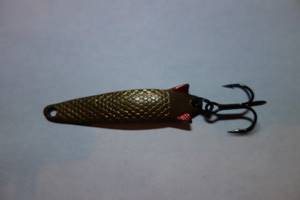
No. 1 Obverse
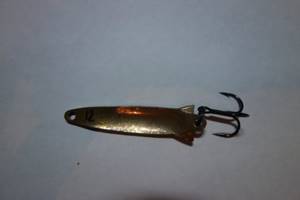
No. 1 Reverse
This spoon bears the proud name “Okhta”, the scales showed a weight of 12g, the material of manufacture is brass. Made by, as far as I remember, it was often included in a set of spinners. I attached a new tee to it.
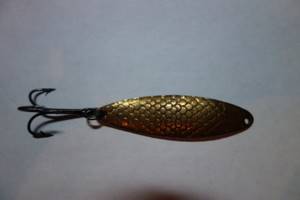
№2 Obverse

No. 2 Reverse
This is a no less famous spinner from the same set, the weight is again 12g, the material is still brass, and it is called “Nevka”. Made at , the original tee is in very good condition.
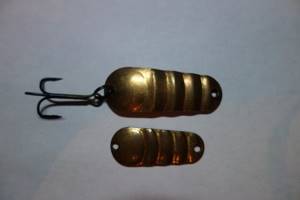
No. 3,4 Obverse
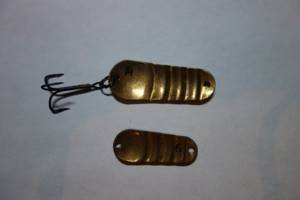
No. 3,4 Reverse
All the same set, brass and manufacturer, name - “Pella”, weights 14 and 6g.
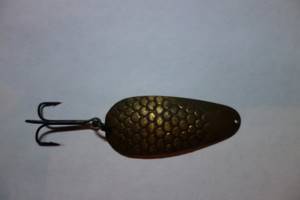
№5 Obverse
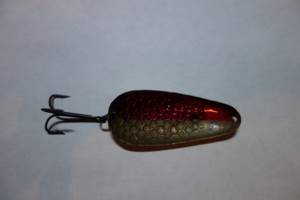
No. 5 Reverse
Brass again, but I’m not sure it belongs to the set anymore. Similar to "Neman" but too light and thin. In addition, customization is already visible here, the inside is half painted red

No. 6 Obverse

No. 6 Reverse
A massive brass miracle weighing 21g, customization has reached a new level, half of the inside is painted red and half is smeared with phosphor paint and glows in the dark.
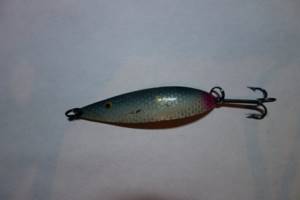
No. 7 Obverse
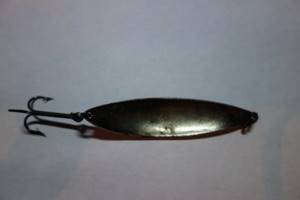
No. 7 Reverse
This narrow-bodied spinner even retained its original color. Weight 14g, stainless steel. I couldn't find the name of this spinner.
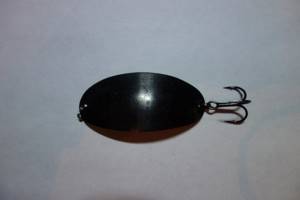
No. 8 Obverse

No. 8 Reverse
At first I decided that it was homemade, and for some reason they had two holes in it in the head part, how wrong I was! It turned out to be a “Mouse” spinner
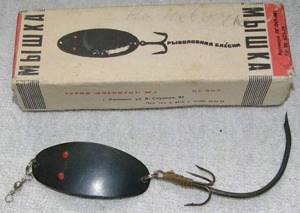
Mouse
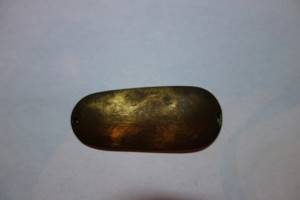
No. 9 Obverse
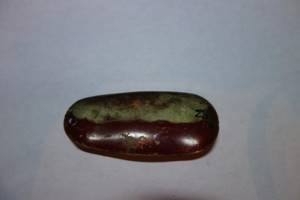
No. 9 Reverse
Brass “Norway” weighing 28g, tuned with red varnish and phosphor paint. (I wonder why it’s always red and phosphorus?)
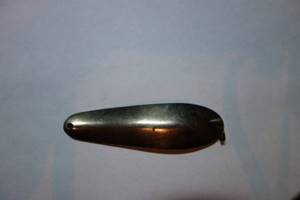
No. 10 Obverse
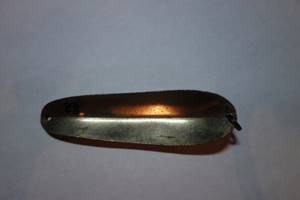
No. 10 Reverse
Another unidentified miracle weighing 28g made of stainless steel.
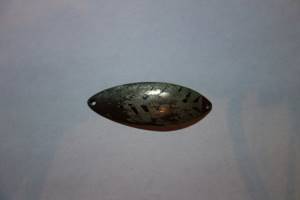
No. 11 Obverse
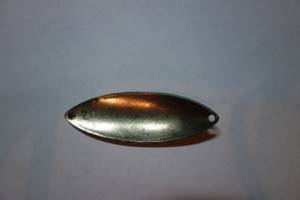
No. 11 Reverse
Another 20g of stainless unknown.
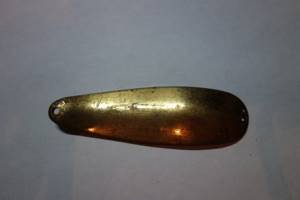
No. 12 Obverse
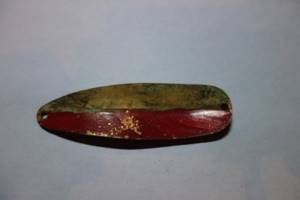
No. 12 Reverse
31 grams phosphorescent red brass, probably Salmon.

No. 13 Obverse
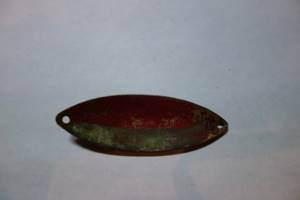
No. 13 Reverse
Guess what two colors they painted it?
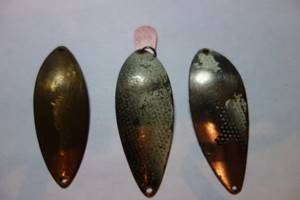
No. 14 Obverse
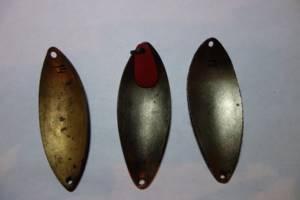
No. 14 Reverse
It looks like the former owner, and part-time spinner decorator, has run out of paint and phosphorus. A series of twins weighing 14g.
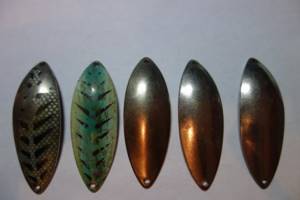
No. 15 Obverse
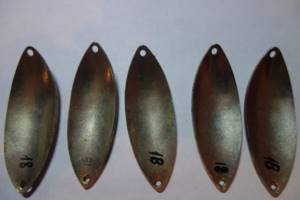
No. 16 Reverse
A series of spinners weighing 18g. The name is again unknown.
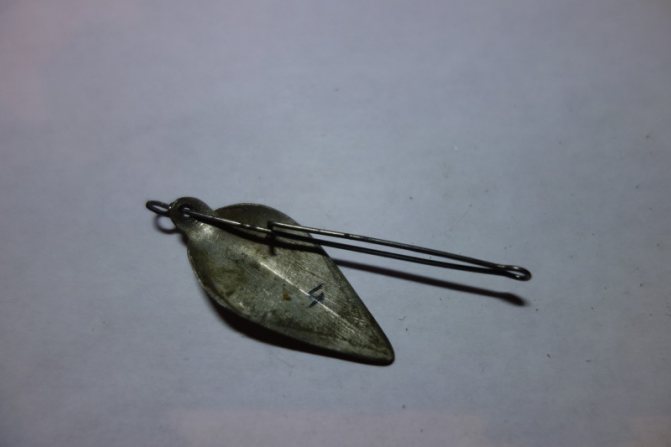
Pinwheel No. 1
The pinwheel seems to me to be homemade, the petal looks like it is made of a sheet of lead and can be crumpled into any shape with your fingers.
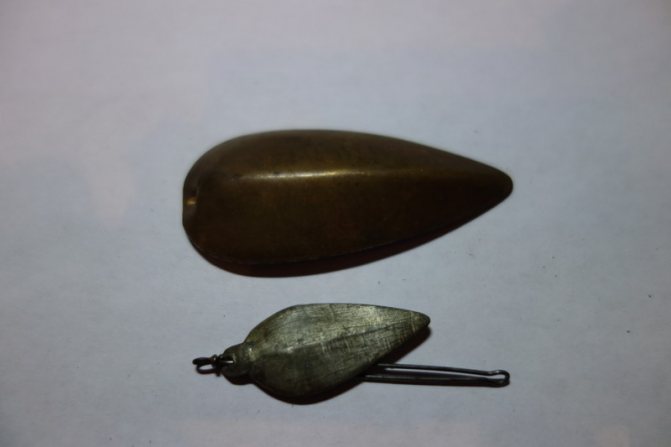
Pinwheel No. 2
These are the remains of the Baikal turntable of a very impressive size.
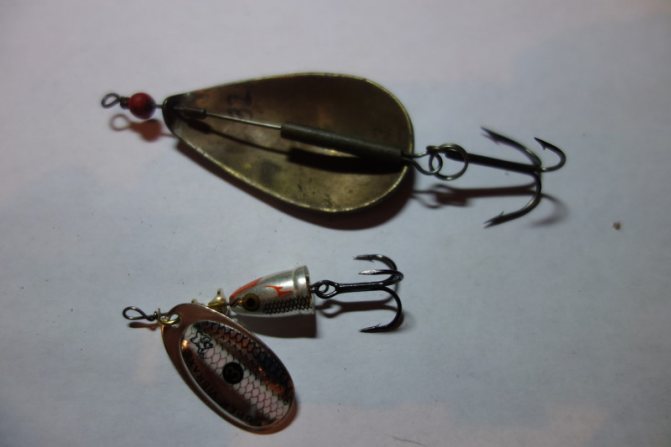
The icing on the cake
This petal weighs 32 grams, 32 CARL!!! Nearby for comparison is number 3 Blue Fox, who is this bullshit designed for... She was probably supposed to break through the Mariana Trench. I’ll definitely try this crap on the water, I’m even wondering if it even starts?
Except for the last copy, all the other spinners seem to me to be quite functional, I sand them down to make them shine, change the tees and rings and off we go. By the way, a question, does anyone know how and with what you can paint the spinners at home? (do not offer red varnish and phosphorus)
The current return of interest in Soviet products is a natural phenomenon
All types of modern baits have been mastered. The advertisement sang one thing, but life puts everything in its place - all types of baits are equivalent in terms of catchability in the conditions where they are appropriate. If we compare the catchability of a spinner and a modern wobbler, I am convinced that the spinner catches no worse.
And if Soviet spinners were so bad, then modern manufacturers would not stick to them. Soviet spinners include all models produced before 1992. During this period and further, right up to the present day, the market was flooded with an incredible number of Chinese and Russian-made baits, with names from the legendary Soviet spinners. But for the most part they have nothing to do with them, differing significantly from the original, and mostly for the worse.
Blitz - tips
Tips and tricks:
- Don’t get carried away by shiny products; in most cases they scare away cautious fish
. Choose spoons based on the nature of the reservoir and fishing conditions. - Don’t get carried away with shiny products; in most cases they scare away wary fish.
- Curved shapes of lures do not show their effectiveness when catching pike.
- For pike, you can successfully use double spoons with additional hooks. The baits are durable and reliable. When falling into the water, they make an unusual sound that attracts pike.
- The most advantageous wiring option will be smooth and slow movements.
- The use of steel or tungsten leaders will allow you to preserve the fishing line and not lose your catch.
- Start fishing a specific body of water at the very bottom, gradually moving to the middle and upper layers.
- After unsuccessful 5 - 6 casts at a slow speed, make the same number of casts, increasing the speed of the retrieve.
Soviet spinners are also not all of high quality
If the winding rings were often normal, then the poor quality of the tees was the order of the day. But this is a removable part of the spoon, and can be easily replaced with a higher-quality modern tee. Much more significant is that the spinners themselves varied greatly. Many models were made from cheap iron, which began to rust even under a protective coating, especially Ukrainian models - Zhytomyr, Kyiv.
Lures were made using the usual stamping method, and, apparently, this was not always normal equipment, they did not always work on it conscientiously, and one batch of lures often had defects - differences in weight, flaws in metal processing. As a result, there are two outwardly similar deceptions, but one successfully catches a predator, and the other is a useless piece of metal.
Types of oscillators. Names of oscillating spinners.
Types of oscillators, how to figure them out?
Oscillating spoons (spinners) were previously the main ones in the arsenal of a spinning player. But even now, with the advent of wobblers, rubber, etc. in the domestic trade, spinners retain their attractiveness for fishermen. This attractiveness is due to the following:
- catchability
- possibility of long casting
- the ability to place the vibrator in different layers of water, including at the bottom and on the surface
- a wide variety of types of oscillators with different sizes and different character of play
Based on the profile shape, I can distinguish oscillating spoons:
- with S-shaped profile
- with C-shaped profile
Separately, kasmasters can be classified as oscillating spinners.

types of C-shaped oscillators

types of S-shaped oscillators
Not all, but some of the spinners have their own names, and the same names are used by different companies producing spinners. Basically, the name of a spinner is determined by its shape. In this case, vibrators of the same shape but different sizes have the same name. At the same time, new spinners are being produced by different companies, spinners are made by homemade craftsmen, and it is difficult to compile a catalog of names of spinners.
The different shapes of the spinners in combination with the s or c-shaped profile determine the nature of the game of the spinners. So for spinners with an s-shaped spinner, as a rule, the wider the back of the spinner in relation to the front, the more active the game. A spoon with a wide front and a narrow back is rare.
Below is a photo of oscillating spinners for pike, pike perch, perch, and asp.
Oscillating spoon ATOM (ATOM)
The general name for a spinner with a narrow front part and a flare towards the back of the spinner.
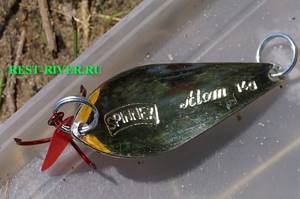
oscillating spoon ATOM (atom)
The ATOM spinner has a very active game; in fast currents, the spinner can go into a tailspin. ATOM is a very popular spinner. Classic sizes 62X24X5 mm 19 g. Mainly used for catching pike, the lure is also used by pike perch and large perch.
STORLING oscillating spoon
A spinner slightly tapered towards the nose.
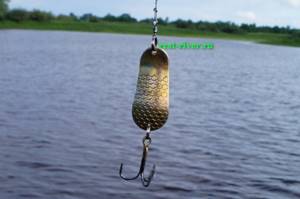
oscillating spoon called STORLING
The spinner is mainly with an S-shaped profile, but there are also C-shaped ones. Available in different sizes up to small perch. Works well in currents and still water. Any wiring speed. Pike and zander are caught using STORLING. The classic dimensions of the spoon are 71x25x5, weight 27 g.
Spinner WILLOW LEAF
The general name for narrow (elongated) spinners.
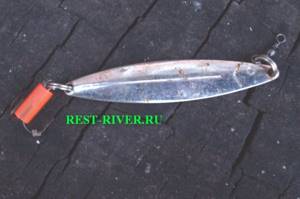
the name of the narrow spoon is willow leaf
The spoon got its name for its elongated shape (designed for the small mouth of asp, pike perch and perch; of course, pike is also caught). It comes in different sizes and weights, from small to large.
see post Weeping willow photo of tree and leaves
AMATEUR spinner
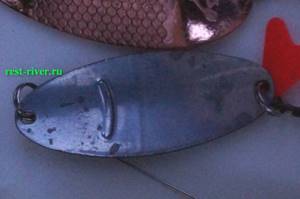
C-shaped oscillating spoon with active play; a spin is possible in strong currents.
Spinner – bay leaf
spinner bay leaf
Spinner for pike, pike perch, asp, perch. The game is active with a corkscrew.
Vibrator colors
Manufacturers offer a wide range of spinner colors. Classic colors metallic and yellow. There is a two-color sandwich. Different bodies of water and seasons have their own colors.
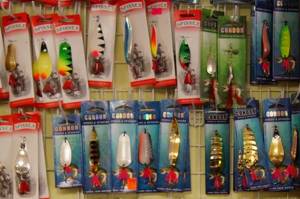
TYPES OF VIBRATIONS
Oscillator sizes
The size of the oscillating spoon is related, firstly, to the casting distance. Compact heavy spoons fly very far. Large, albeit heavy, spinners have a short casting range. Small casting range for light spoons. Secondly, light spinners are designed for fishing in the upper layers of water (asp fishing), heavy spinners are designed for fishing near the bottom. Thirdly, small spoons for catching perch and asp. Large for pike and zander.
Spinner SKUMOVKA
There are two types of skimmers.
- Sandwich, when one half knocks on the other (double spinner).
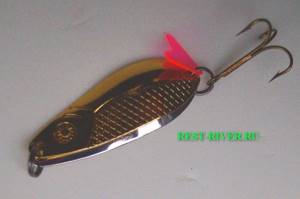
2. Ribbed skimmer, usually with a C-shaped profile. The noise comes from the passage of ribs in the water.
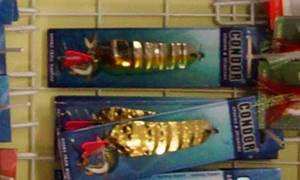
ribbed oscillators - skimmers
Storage of spinners
In a spinning player’s arsenal, oscillating spoons are the most noisy, especially when they are in plastic boxes. Previously, fishermen sewed special covers from leatherette in cells like a spinner. Bags for storing spinners are currently on sale. Inside the bag there are cells made of soft polypropylene, into which the anchors of the spinners are stuck. The bag can be hung on a belt. There are zippered pockets for other spinning accessories.
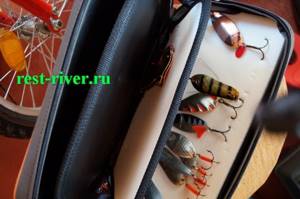
storing spinners in a bag

storage bag for oscillating lures
The spinners were also designed differently
Someone took world-famous spinners as a model and, with varying degrees of success, riveted replicas, giving them their own names. Someone created truly original spinners, without the usual 3D modeling for today's practice, but making the bait on a whim, often from tips from the experience of Soviet spinners. That is, even then the baits were created by different people who understood well what they were doing; and amateurs who are far from real fishing.
As a result, many models of Soviet spinners fell into oblivion due to their almost zero catchability. And I haven’t heard that even collectors are chasing them - why collect junk that is not able to catch fish? But the excellent lures remain, and interest in them is only growing. After all, this is both our glorious history of spinning and simply high efficiency. And I am not at all surprised by the excitement that has arisen in recent years around Soviet spinners when catching large perch and pike.
Pike fishing: fishing lines used
When an oscillating spoon falls into the water, it produces a characteristic splash, which has an exciting effect on the fish.
When fishing for pike, correct fishing is important.
In open water you can hunt for pike using vertical lures, spinning rods, and trolling.
The most successful time for fishing is early spring, 7-10 days after the end of the spawning period.
If you conduct spinning fishing, then use a uniform retrieve, casting the tackle a little further from the predator’s shelter.
Wait until the bait sinks, support it with the tip of the tool and begin to slowly and evenly rotate the reel handle.
Good results are achieved by varying the bait - first the spoon should be placed on the bottom, and then raised to form a cloudy cloud.
Another way to attract pike is a chaotic game, in which the spinner imitates the agony of a wounded victim.
You can use the twitching method. It is a jerky reeling with twitching of the tip of the fishing rod.
Stepwise retrieving is performed as follows: make a few turns with the reel, stop, reel in the line again, stop again. Continue in this order.
When using the trolling method, hunt along the underwater edges and grass edges. While the boat is moving, control the depth of the bait, experiment with types of animation and fishing horizons.
When an oscillating spinner falls into the water, it produces a characteristic splash, which has an exciting effect on the fish, so the bait can be captured at the very beginning of the spinner's dive.
Be careful here, constantly monitor the bait to ensure timely hooking. Pike is a fairly serious and intelligent opponent that can quickly determine the inedibility of a product.
Fish carefully, slowly, so that the fish gets tired and offers less resistance. A landing net is required.
Lure test according to the Olympic system
I have already collected a lot of working spinners from the times of the USSR. And I’m trying to catch everything, thoroughly testing, trying to be as objective as possible. Test according to the Olympic system - the weak one is eliminated. That is, I arrange competitions between baits and each other, the main arbiter is a predator, and I am, as it were, a demanding fan.
To exclude the possibility of chance, I test baits for quite a long time, about two years, and each spoon works in different bodies of water. Initially, I divided all the baits into groups, forming them in a random order - as the hand lays. On a particular fishing trip, each bait makes about 10-15 retrieves, then changes. On my next fishing trip on a different body of water, I again make a dozen casts each. And so in a circle, fishing after fishing, season after season. After a couple of years, favorites and outsiders are calculated. The latter are sent to the “archive”. And those who distinguished themselves gather in their own groups, where they begin to compete with each other. Typically, any bait works well only in certain conditions, and to understand this, you need to experiment a lot and record the results of each bait.
The weight range of my “iron” is from 4 to 55 g. The most universal ones are from 14 to 20 g, with which you can fish the entire water area on deep lakes and rivers. But what is universal is not the best thing, and that’s certainly true in vibrators. With a super-heavy spoon, you can really fish the pit dumps very thoroughly, no worse than with a jig. And lighter, wider spoons are very good for fishing in overgrown shallow waters, in no way inferior to twitching wobblers.
I don’t immediately reject any new bait that comes into my arsenal. Only after thoroughly testing do I come to a conclusion. At the same time, I cannot understand why lures that are largely similar, both in game and in size, selectively affect pike of different sizes. Let's say, one model perfectly collects fish up to 2-3 kg, and a large pike turns up its nose at it, no matter what kind of wiring you offer. And the other spoon catches small pike well, and clearly attracts specimens weighing 3-5 kg. There is also a small spoon (one side is copper, the other is steel), I don’t know how it is made, but the perch sits on it very actively, and the pike completely ignores it.
Choice of spinners
Lures with a shiny surface are distinguished by their high catchability, but use them carefully so as not to scare away the pike
Color:
- Use brightly colored vibrators on cloudy days, and dark and dull ones on sunny days. Playing in contrast will allow you to quickly orient the fish and provoke it to capture. The main condition is that the spinner should be as noticeable as possible.
- Lures with a shiny surface are distinguished by their high catchability, but use them carefully so as not to scare away the pike.
- Black spoons are suitable for fishing in clear water; they will be much easier for predators to detect.
Size:
- To hunt pike, equip your tackle with large models.
- Spoons up to 7 cm in length will be effective for catching predators in summer and autumn, and in spring - spinners with a length of 8-17 cm.
Lure weight:
- At depth, heavy spoons that can easily submerge into the water will work effectively.
- On the surface, use light vibrations.
Important! For pike, the best option would be wide and flattened spoons.
Hook: Select the hook size of your spinner according to the intended size and type of prey. In this case, the hook itself should not be wider than the bait. Otherwise, the likelihood of catching a pike decreases.
The traditional option for equipping the shaker is to use one tee in the tail section.
How to use
The Ulyanka spinner is a spinner measuring just over 6 cm and weighing up to 10 grams, designed for single-ton bottom fishing. The main type of fishing with this spinner is slow. When moving evenly, the bait creates two types of vibrations: high-frequency, caused by vibration of the plate, and low-frequency, caused by body movements from side to side.
To allow the spinner to move in the water column or closer to the bottom, a slow retrieve is performed with the tip of the spinning rod lowered. During the retrieve, it is possible to revive the game in the form of wrist movements with the rod, during which the spoon scurries from side to side. The spoon showed itself well both when casting and when fishing using the twitching method. Trolling fishermen said that the spoon catches well at various depths. As practice shows, when trolling it is best to attach the bait to the top hole, when casting - to the middle hole.
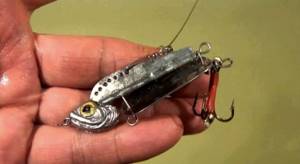
When trolling, the fish is caught on its own, except when it attacks from behind. When fishing, the cord must be constantly tensioned; the predator's throws are dampened by the elasticity of the tackle. When fishing, you must strive to ensure that the rod makes an angle of 90 degrees with the fishing line. It is necessary to avoid a situation where the rod is in a straight line with the line. This may cause the cord to break. The spoon is effective when catching predators at any depth and in different conditions. With its skillful use, the chances of catching trophy fish increase significantly, especially in large bodies of water.
Design Features
This is a universal predator bait. When fishing with the Ulyanka, both hard and softer rods are used. With each cast it flies quite far. We make several slow revolutions and let it sink to the bottom. This lure can be fished both by trolling and casting. In the front part there is a weight that allows it to go deeper.
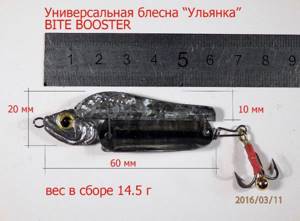
In order to make Ulyanka with your own hands, you will need:
- an ordinary oscillating spoon with the rings removed;
- tin plate for creating a comb;
- steel wire for connecting the plates to each other;
- winding rings and tee hook;
- metal load.
Drawings, which you can get from the developer’s website, will help you understand the intricacies of creating bait.
